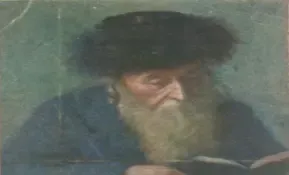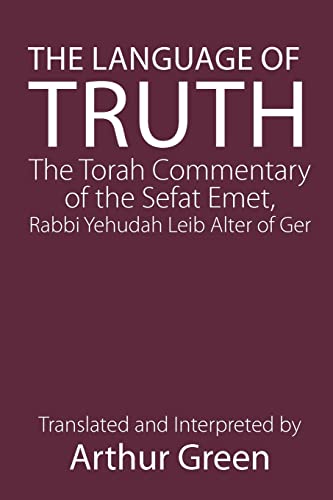Shabbat Gathering: Who/what is the Sefat Emet?

Dear Chevra, as is our custom, we will gather tonight at 5.45p ct to welcome Shabbat. These are the coordinates:
Zoom
Meeting ID: 963 5113 1550
Password: 1989
Phone: +1 312 626 6799
(To unsubscribe from the newsletter, click the link at the very bottom of this email.)
Here we go.
About a year and a half ago, Shaarei Shamayim initiated a program for people who wanted to meet up virtually during the pandemic. I matched with Don Katz and we fell into a weekly Torah Study routine. It’s been a rewarding experience for us. This past Simchat Torah, we needed to decide the theme for this year’s Torah Study. This year, we’re going to look at the weekly parsha through the lens of the Sefat Emet. Sefat Emet is a terrific Torah commentary and I highly recommend it. Here’s what it’s all about.

First, who/what is Sefat Emet?
Yehudah Aryeh Leib Alter (1847 - 1905, Poland) is the real name of the scholar referred to as Sefat Emet. (Just like today’s rappers, ancient Torah scholars adopted cool nicknames.) He is regularly cited as one of the greatest Torah scholars of his generation. The body of his work is titled Sefat Emet and focuses on the weekly parsha drawing on sources including Talmud, Midrash, and the mystical text called the Zohar. The Sefat Emet was married twice and had ten children. He did not take money from his students. Instead, he ran a grocery store.
But the Sefat Emet didn’t write anything. Instead, his students listened to his weekly Shabbat drashes over the years and then wrote down notes about the drashes after Shabbat was over. The notes are organized by parsha and by year. So, for example, we have “Sefat Emet, Bereishit - 1886.” One of the things that happens is that the reader can chart the evolution of the Sefat Emet’s thinking over time. In general, there aren’t great changes in his thinking, but there are some interesting and subtle shifts in content and a changing emphasis of his sources.

Window onto Sefat Emet.
There isn’t a word-for-word English translation of Sefat Emet. Arthur Green’s book, The Language of Truth: The Torah Commentary of the Sefat Emet, translates portions from the Sefat Emet and then intersperses those portions with Green’s commentary. Don and I are using this source and we are also using a newsletter from the Institute of Jewish Spirituality called “Noticing the Nekudah.” Sefaria has started a crowdsourced effort to translate the Sefat Emet into English but it is in a nascent stage. Matthew Banks writes a weekly “Welcoming Shabbat” newsletter for Beth Israel and he usually draws his lesson from the Sefat Emet. (And it was Banks who inspired me to write the Shabbat Gathering newsletter.) Hadar sometimes offers an excellent course on the Sefat Emet which is why I know something about this topic.
The Sefat Emet’s connection with Chassidus.
The Sefat Emet falls into a category of Jewish thinking that’s known as Chassidus which traces its roots back to the Baal Shem Tov (1698 – 1760, Poland) and forward to its current incarnations into various Chassidic sects such as the Lubavitchers, Satmars, and many more. Renewal Judaism has a streak of Chassidus in it. Chassidus emphasizes prayer as a direct connection to the divine and ecstatic joy as a symptom of a successful connection. There’s also a focus on mysticism.
Sefat Emet on this week’s Parsha.
Here’s an extract from the opening of one of the Sefat Emet’s drashes on this week’s parsha, which I think has a special message for those of us at our Shabbat Gathering.
It is said that Abraham cleared the way for all who are exiled. “Israel were exiled only so that converts would be added to them.” This means drawing all creatures near to Torah. Therefore, Abraham chose to take himself to all these places, in order to set them right and raise them up.
There are particular lessons we can learn from this Sefat Emet’s Vayera drash, but the general lesson I want us to learn is that the Sefat Emet offers an easy-to-understand reading of the Torah portion and a clear lesson based on that reading. And this is probably the reason that the Sefat Emet is so popular to study these days.
And may it be for all of us a blessing.
See you tonight!
Gut Shabbes!
All my love,
brian.
PS - Ecstatic Music

When I think about Chassidus and the joy we feel when we’re connected with Hashem, my mind typically moves to music and dancing and the type of joy I feel when I listen to something I especially like. I don’t think many people think about Little Feat as a sacred experience, but I do, and I especially think of this song as something sacred for me. “Just give me one clear moment. I can turn your head around.” For me, this is my ecstatic feeling when I connect with Hashem. And the beat makes me move. Let it roll.
https://tidal.com/browse/track/10206045